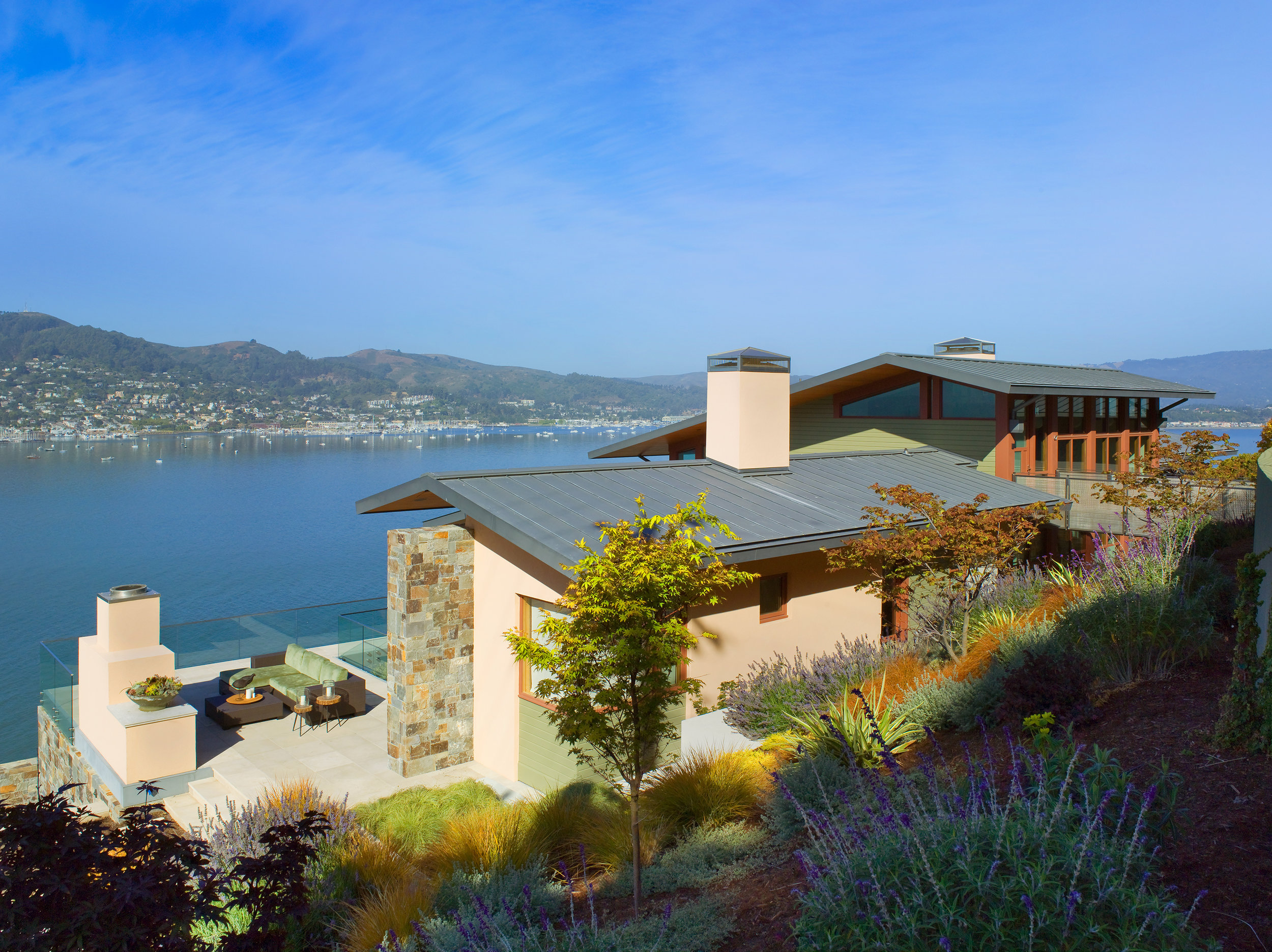California Home And Design Magazine
——-
featuring
HILLSIDE RESIDENCE
“ Exposed wood ceiling beams, plaster walls and wood or limestone floors all conceal the building's reinforced concrete armature…”
“Inside a three-story wood, stone and glass house on Belvedere Island, a series of bridges and pavilions allows you to pause in the handcrafted spaces and contemplate the views in every direction, At the edge of the steep lot, a swimming pool seems to hover in the back garden and cascade into the Bay. The house, designed by Mill Valley architect Ron Sutton of Sutton Suzuki Architects, is simultaneously intimate and exposed, with an open-air quality enabled by its solid steel structure.”
Interpretation of Dreams
Inside a three-story wood, stone and glass house on Belvedere Island, a series of bridges and pavilions allows you to pause in the handcrafted spaces and contemplate the views in every direction, At the edge of the steep lot, a swimming pool seems to hover in the back garden and cascade into the Bay. The house, designed by Mill Valley architect Ron Sutton of Sutton Suzuki Architects, is simultaneously intimate and exposed, with an open-air quality enabled by its solid steel structure. "Our dream was to build a house like a spa-a contemporary home with a pool," says financial consultant Scott Nirenberski, who with his wife, interior designer Andra Martens, moved into the boxy mid-century home that stood on the site in 1997. Though it didn't have a pool, the two-story Eichleresque house did have stunning views of Sausalito and San Francisco, and for five years the couple lived there happily. During that time, their first two boys were born. As Nirenberski approached 40 and Martens was pregnant with their third son, they decided to consolidate the house next door, which they acquired in 1999, and build the home they had always wanted. "After you have children, the dream changes," Martens says. "In addition to our serene spa getaway, we also wanted a family home." Outdoor play spaces for Carson, Austin and Logan (now 10, 8 and 4, respectively) topped their list of priorities for the combined half-acre lot. After three rounds with Belvedere's design review board, their initial plans for an aggressively modern, somewhat monolithic structure were abandoned in favor of this intriguing, meandering 6,000-square-foot split-level home.
"The city's size restrictions impacted our original design, but that led to more decks and indoor/outdoor spaces," Martens said. Sutton's strategy was to break the house into three pavilion forms with standing-seam metal roofs.
Architect Ron Sutton, with his client interior designer Andra Martens, chose a central wall of Montana ledge stone that not only provides thermal mass but adds dramatic texture to every room, including the kitchen where it abuts the wood rafters. The two main pavilions, which contain the living spaces and bedrooms, are linked together by a three-story stone wall that runs along the north south axis. In the northeast corner of the lot, the third pavilion contains the garage and, directly below it, Martens' design studio.
The journey through the house starts at Nirenberski's mezzanine office that overlooks the open-plan living/dining room, which is flanked by a media room at one end and an expansive kitchen at the other. Downstairs, the children's bedrooms and playroom are linked by a wide, stone hallway that can withstand roughhousing and the occasional game of catch. The master suite at the north end of the hallway has an open-plan dressing room and bath, with a bathtub encircled by glass walls that face the Bay. At the opposite end, guest quarters are separated from the family rooms by an outdoor courtyard big enough for the boys' trampoline.
(The living room presents a well-edited selection of Martens' favorite designs. Modern classics, including the orange Jens Risom chair from Ralph Pucci, mingle with handcrafted pillows and found objects like a wasp's nest. The painting over the buffet is Chasin;; by Sanjay Vora.)
To separate her workspace from the rest of the house, Martens, who is originally from Anchorage, designed what she calls an "Alaska Zen" garden. "It has ferns and birch trees that remind me of the landscape there," says the designer, who helped select many of the plantings. Succulents and other drought-resistant plants grow along the driveway, a vegetable garden is built into the southern hillside and artificial turf surrounds their coveted pool.
"Building this house was essential to my understanding of green design," says Martens, who recently established her firm, Andra Martens Sustainable Design. "I was mildly interested in it before, but did not know much about it until we started on this project." Originally meant for commercial and civic buildings, LEED guidelines were being reconfigured for homes just about the time Nirenberski and Martens broke ground in 2004. Deciding that their house should incorporate these green principles, they specified low- and no-VOC paints and chose FSC-certified mahogany and other hardwoods for beams, windows and floors. Martens also asked for deeper sun-shading eaves to mitigate unwanted heat in areas where the sun would have flooded in through large picture windows.
Sutton obliged and also added other eco-conscious touches for his clients. The five-inch-thick Montana ledge stone that covers the central wall is not decorative cladding: It acts as thermal mass to retain the day's warmth on cool nights and remains cool during warm days. Transom windows are strategically placed for cross ventilation and on most sunny days, when the Bay's fog never reaches the island, no other cooling system is required. Nirenberski, familiar with extreme cold and heat from growing up in Toronto, Canada, insisted on installing an air-conditioning system, but found a green solution that distributes excess heat into the swimming pool and uses cool water from the pool to chill air in the house.
Green design principles influenced Martens' choice of furnishings as well. She picked out a fallen cypress tree reclaimed from Golden Gate Park and had it milled for shelves and a bed; old vinyl records decorate Carson's bedroom because he loves music; found botanicals and abandoned birds' nests are welcome accessories in every room.
Even the home's color palette is directly inspired by nature. "1 went with the children to the Marin Headlands, and we gathered stones, grass, leaves, mud and flowers and matched those colors," Martens says. Orange accents that represent California poppies dot the interior, and the neutral hues of rocks or colors of the sky are repeated in artwork and in upholstery fabric. A set of Eero Saarinen chairs are covered in a bold blue ultra suede.
(The master bathroom is part of an open-plan dressing area, centered around an ovoid Agape bathtub, Outside the window, fast-growing bamboo offers privacy from the neighbors, BELOW: In the bedroom, a walnut bed from Ruby Living adds a rustic note.)
Though it took seven years to refine their design, Martens points out the silver lining that the children were all old enough to watch and learn how a building is put together. "They got to see both the old houses being torn down, how concrete is poured for new foundation and how stones are laid for paths," Martens said.
Exposed wood ceiling beams, plaster walls and wood or limestone floors all conceal the building's reinforced concrete armature, but there are many reminders-the equivalent of historic photographs in an album-of how the house was built. "We deliberately left many of the steel beams exposed so the children continue to recognize how our house is held up," says Martens, who hoped for a house that would mature with her sons. In a few years, when the sandbox, the swing set and the trampoline disappear, the home's versatile framework will still sport perennial family diversions: the outdoor fireplace, the putting green and the poolside spa.



